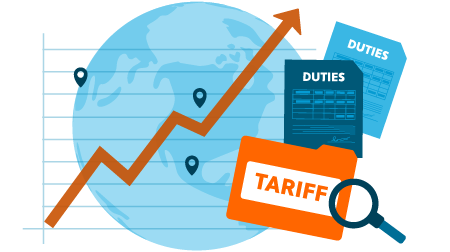
Tariff turmoil — Wacky Tax Wednesday
Talk of Trump tariffs has dominated news cycles since the 47th president returned to the Oval Office. Tariff changes are part of the “Trump Effect,” according to the White House, and their effects are being felt nationwide.
Businesses certainly feel the impact when tariffs change virtually overnight.
Understanding Trump tariff policy changes
The elevator speech goes something like this.
On February 1, 2025, President Donald J. Trump announced new tariffs on Canada, Mexico, and China. He also eliminated their de minimis exemptions, which allow low-value shipments (less than $800 per person, per day) to enter the United States duty free. The tariff changes were all to take effect at 12:01 a.m. ET on February 4.
Then, on February 3, the president paused the U.S.-Canada-Mexico tariffs to allow time for negotiations. If discussions don’t yield the desired results, the same (or different!) tariff changes could take effect in early March.
The China tariffs moved forward as planned on February 4, but the de minimis exemption change didn’t stick. On February 5, the president reinstated the exemption for low-value imports from China to allow the U.S. time to implement systems to effectively process and collect tariff revenue from low-value shipments; news of the reinstated de minimis exemption didn’t really break until February 7.
Lastly (though probably not last), President Trump announced new steel and aluminum tariffs starting March 12. He’s also pursuing new and/or reciprocal tariffs on U.S. trading partners.
If you’re unfamiliar with President Trump’s tariff plans, the following blog posts can help you get your bearings. They’re being updated as new information becomes available.
How to handle last-minute tariff changes
It’s hard for businesses to comply with last-minute tariff changes that may or may not stick. And businesses aren’t the only ones. It turns out the Secretary of Commerce and the United States Customs and Border Protection (CBP) needed time to implement “adequate systems ... to fully and expediently process and collect tariff revenue,” as President Trump observed in an executive order. So, he gave them more time.
Businesses weren’t given the same leeway. Affected items that were in transit when the tariff changes were announced were not allowed to enter the country unless and until the new tariffs were applied. This caused pileups at customs and confusion at the United States Postal Service (USPS).
USPS went so far as to briefly halt inbound packages arriving via China and Hong Kong Posts. Then, on February 5, USPS said it “will continue accepting all international inbound mail and packages from China and Hong Kong Posts” and that it was working closely with CBP to “implement an efficient collection mechanism for the new China tariffs to ensure the least disruption to package delivery.”
This was welcome news. And it makes me wonder, why couldn’t a similar grace period have been provided for businesses?
Instead, for a few days, some businesses and/or consumers had to pay tariffs on items that previously qualified for the de minimis exemption. And they can’t ask for a refund of the duty paid. Per a Federal Register Notice dated February 12, 2025, “As of February 10, 2025, there will be no retroactive application of these changes for any shipments that would have otherwise qualified for de minimis treatment based on the February 5, 2025, Executive Order.”
Affected businesses also need to charge, collect, and remit any other new tariffs, including the tariffs on China that went into effect on February 4.
Tax compliance is often challenging for businesses during the best of times. When governments impose last-minute tax policy changes with little to no guidance, tax compliance becomes even more difficult. It forces businesses to scramble for information and solutions.
“Businesses are feeling the whiplash from the on-and-off changes of the past two weeks,” says Shane Bogdan, Director of Cross-Border Sales at Avalara. “Conversations with our clients and supply chain professionals at the Manifest Conference last week revealed widespread confusion and uncertainty.”
Fortunately, tax compliance software services help businesses be prepared for international tax changes whatever they are. “The most effective way to navigate this volatility,” says Bogdan, “is through a proactive strategy, leveraging agile solutions that provide near real-time updates on duty changes and HTS classification requirements.”
Avalara Cross-Border automates tariff code classification and delivers real-time calculation of customs duties and import taxes. We shoulder the most burdensome aspects of tax compliance for our customers.
We can help you too. Schedule a call today for more details.

Simplify cross-border tariff compliance with automation
Stay ahead of changing trade regulations with automated tariff code classification and duty calculations
Stay up to date
Sign up for our free newsletter and stay up to date with the latest tax news.














